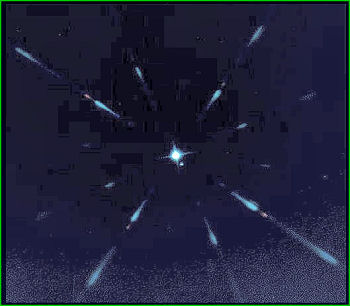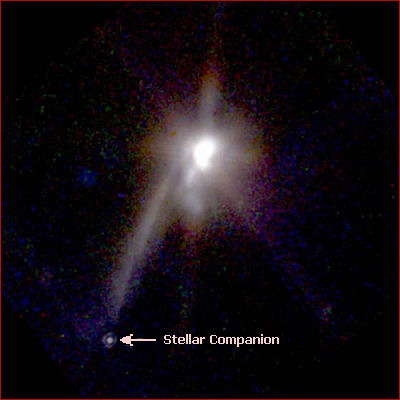Star Types
BINARY STARS




Binary Terms
Ψ A Binary or Double Star - a system consisting of two stars orbiting about a common center of mass. They often appear as a single object (star) in the night sky or even when viewed through a telescope.
Ψ X-ray binaries - are pairs of stars that produce X-rays as a result of their proximity to one another, causing material to be pulled from the normal star by the gravity of the much denser collapsed star. The area where the material that is falling is heated to very high temperatures - over a million degrees - and is the source of the x-ray emissions: this area around which are the source of the x-rays is called the:
Ψ Accretion Disk - when physical matter is pulled from a stellar object or source into another via a large gravitional field of attraction; often associated with black holes and regions of star birth. To view an animation of a pair x-ray binary stars and accretion disk see the Goddard/NASA website X-ray Binary Stars.
Ψ Ephemeris of Binary - here is a downloadable program from Alejandro Eduardo Russo's website Binary Stars. The software is called “EFEBIN07”, an abbreviation for “Ephemeris of Binary” and the program is version 2007. The file is in zip compressed format and is 236kbs in size. The author has provided this software package as a free download.
Binary Pairs
In a binary star system, each star of the pair follows an elliptical orbital path. Mutual gravity causes the stellar companions to glide around their orbits as if tied to the ends of an elastic string passing through a balance point between them. The balance point is the system's "center of mass". See: APOD - Mizar Binary Star

Above is the binary stars Sirius A and the white dwarf Sirius B (lower right)
Credit: NASA Image Gallery (NASA/SAO/CXC)

This NASA Hubble Telescope near-infrared image of newborn binary stars (image center) reveals a long thin nebula pointing toward a faint companion object (bottom left)
Credit: NASA Image Gallery
This image shows a newborn binary star system, CoKu Tau/1, lying at the center of four "wings" of light extending as much as 75 billion miles from the pair. The "wings" outline the edges of a region in the stars' dusty surroundings, which have been cleared by outflowing gas. A thin, dark lane extends to the left and to right of the binary, suggesting that a disk or ring of dusty material encircles the two young stars. Credit: ESA, D. Padgett (IPAC/Caltech), W. Brandner (IPAC), K. Stapelfeldt (JPL) and NASA
Perhaps one of the most beautiful looking binary systems is the Albireo Binary pair pictured above. In natural contrasting colors and viewable with a small telescope this is a gem for any astronomer to discover. Image credit: Hunter Wilson under license Creative Commons Attribution ShareAlike 3.0
System Types
In astronomy, binary pairs are catagorized under a system that is based either upon how they appear or how they are detected:
1 - Visual Binaries describe two stars that can be individually discerned through a telescope and fall under two sub-types:
a) Physical Binaries occur when the two stars are actually orbiting one another
b) Optical Binaries occur when the stars appear very close together in the sky, while they are in fact very far apart and not gravitationally bound
2 - Spectroscopic Binaries describe a system that is confirmed as Binary through the use of spectrum analysis. As two stars orbit one another their spectral lines will periodically be shifted up and down in wavelength. This action is measurable from earth due to the effect produced upon the measured spectrum of one star as it moves away from us while the other star is moving towards us, causing the spectral lines to shift up and down periodically and out of phase.
3 - Eclipsing Binary is a binary star whose components pass in front of each other, thereby causing a regular eclipse of one of the stars.
4 - Astrometric Binary is a binary system which is inferred based on the gravitational influence that a companion star has on the proper motion of a primary star. The effect on the primary star is viewed as a "wobbling" motion. This was the case involving Sirius A and the discovery of it's stellar companion Sirius B. The binary was originally classified as astrometric until the advent of more advanced imaging which proved the existence of Sirius B visually.
Current Science Regarding Binary Systems

Chandra X-ray image of Sirius A (upper right) and Sirius B (lower left) (NASA/SAO/CXC)
The theories regarding the developemental formation of binary star systems and the number of such systems existing in the universe has changed over the years; once thought as being the exception they are now seen as much more numerous, even comprising up to half of current star systems. Their formation include theoretical discussions under Star-disc interactions-ring fragmentation, Isolated Binary-Star Formation, Fragmentation of protostellar cores and the early developmental process theory of a Fission Mechanism for Binary Star Formation. While the last of these had, in it's original form, encountered theoretical difficulties due to the created model's "highly idealized" conditions and unsolvable instabilities, recent revisions have given this theory more credibility regarding how stars divide into binaries at the protostar stage.
For further reading see the following:
Planets with Two Suns Likely Common at Space.Com.
Chandra X-Ray Observatory website page entitled "Binary and Multiple Star Systems"
National Optical Astronomy Observatory article entitled "Majority of Planetary Nebulae May Arise from Binary Systems"
For further study see:
Department of Physics, University College, Cork, Ireland
The Black Hole/Neutron Star Binary Research Group offers publications and research into X-Ray binaries.
Louisiana State University, Department of Physics & Astronomy [College Level +]
THE FORMATION OF COMMON-ENVELOPE, PRE-MAIN-SEQUENCE BINARY STARS which includes animation models of binary developement.
Ask an Astrophysicist [Intermediate Level +]
Answering the question, How are binary star systems formed? with a discussion of the formation of Binary Stars at Goddard/NASA's website.
Additional Information & Resources
Binary Star Systems
Chandra X-Ray Observatory
Ψ The Chandra X-Ray Observatory website explains the different types of binary star systems. Includes satellite photos, and demonstrational videos. Intended for high school and above.
Kepler Planetary Orbits
Ψ A Java script demostrating the orbits of a binary pair. The applet is configurable and includes astronomical information based upon user entered parameters.
Binary Star Simulation
Ψ Try a binary star simulation where YOU can change the masses of the stars, their orbital separation, and a few other parameters. Astronomy 101/103, Cornell University, Terry Herter.
Information-Links
Ψ This Web site contains alot of information, links and some very practicle software related to binary star systems. It is maintained by Dan Bruton of the Department of Physics and Astronomy at Stephen F. Austin State University. For students in high school and above.
This Page
BINARY STARS
Next Page
Protostars
Back to The
Star Page Main
Back to The
Main Page
This Page
BINARY STARS
Next Page
Protostars
Back to The
Main Star Page
Back to The
Main Index Page
Nebulas Surrounding Wolf Rayet Binary APOD

Y. Naze, G. Rauw, J. Manfroid, J. Vreux (Univ. Liege), Y. Chu (Univ. Illinois), ESO
Protostars
Brown Dwarf
White Dwarf
Red giant
Variable Star
Neutron/Pulsar Star
Below - Work in Progress
Supergiants
Quasars